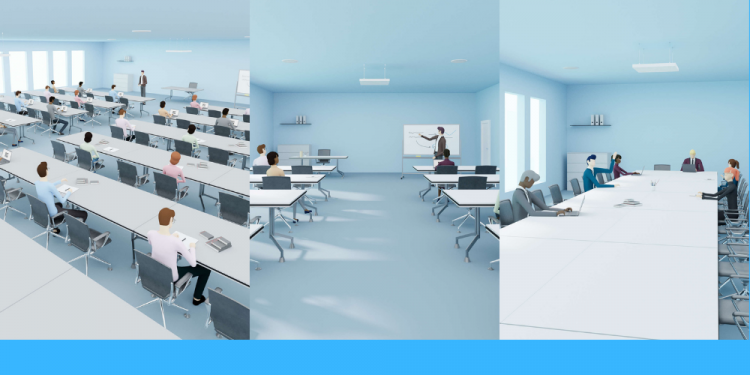It is no secret the world is going through an important transition. The pandemic has altered the way we relate to the space around us, with person-to-person proximity a particular challenge inherent to conference rooms and auditoriums. Whilst the solution may seem straightforward – let fewer people in and keep them well apart – social distancing can also pose unique challenges to both corporate and educational worlds.
………………………………………………
Apart from the obvious restrictions in communication and being able to understand each other clearly whilst physically far apart, several factors such as colleagues joining remotely, chatty students, air conditioner noise, repetitive sounds like typing and tapping as well as poor room acoustics may have a significant impact on how people interact with a presenter and each other.
With companies and educational organizations looking to adapt their current spaces to the new requirements, re-evaluating existing A/V equipment becomes crucial.
Looking at the bigger picture
With some joining meetings or seminars in person and others participating virtually via conferencing apps such as Zoom or Microsoft Teams, an effective audio ecosystem can be created which not only links virtual attendees with the presenter, but also looks at the bigger picture: ensuring good quality audio in the room.
Voice lift technology plays a crucial role in achieving the latter. It uses the components of a traditional sound system in order to deliver voice amplification for all participants in a room. The beauty of such a system is that it increases the speech level by just a few dB to account for decreased speech intelligibility due to the distance between people in the room. The effect is so subtle that it is often not even noticed by physical attendees, let alone virtual participants.
Like a conventional sound reinforcement system, voice lift technology needs components such as microphones, amplifiers, digital signal processors and loudspeakers. And – in times of Covid-19 and beyond – it is the microphone side that presents the most convenient option for optimising a voice lift system.
How a ceiling microphone can optimise your voice lift system
Ceiling microphones ensure ‘touchless audio’ through their beamforming microphone array technology – no need to pass around or share microphones. Not only does a ceiling microphone allow for a safe social distance between all participants, it also encourages both physical and virtual interaction between all participating groups, making conferences, lectures and seminars feel much more natural.
The convenience for speakers and lecturers should not be underestimated either: They can simply walk into the room and know that everything works without the need to locate a handheld microphone, attach a lapel microphone or stay in front of a table top mic. They can simply focus on their presentation or lecture, hands-free, with the re-assuring feeling that everybody in the room or connected remotely will understand them perfectly.
In this context, Sennheiser’s TeamConnect Ceiling 2 (TCC2) is a particularly appealing solution. Its automatic adaptive beamforming technology follows the active speaker’s voice, allowing them to speak naturally whether they are sitting, standing, or moving around.
A look into the future:
Hybrid meetings and seminars are here to stay: The advantages they offer for corporations and higher education facilities beyond touchless audio and convenience are obvious. Adding voice-lift technology will make these hybrid experiences agreeable for the teams and students on site. The combination of ceiling microphone and voice lift system delivers a very natural and seamless communication experience between all members of the discussion, whether situated in the same room or participating remotely.




















